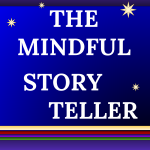
“At one time most of my friends could hear the bell, but as years passed, it fell silent for all of them. Even Sarah found one Christmas that she could no longer hear its sweet sound. Though I’ve grown old, the bell still rings for me….” – Chris Van Allsburg, The Polar Express
∞∞∞∞∞∞∞∞
Your best storytelling instructor may be a toddler. They are masters of imaginative play. Toddler play lacks the awkwardness of self-consciousness. Their imagines are reality.
Storytellers conspire with their listeners. Together, we create worlds. Honing the craft of storytelling involves developing the ability to “turn on” one’s imagination, learning how to generate vivid images within yourself so that your audience may do the same. Here, the toddler may be your teacher. When engaged in this creation with young listeners, the storyteller holds an especial responsibility.
As a professional storyteller, I sometimes find it necessary to “tone down” my storytelling performances when I am sharing tales with very young children. Everything I say is real and alive. A bumbling green-hairy monster may be quite amusing for 4th and 5th graders. That same monster can be terrifying to a 4- or 5-year-old.
If you are a teller who shares tales with young children, you have an obligation. Whether your listeners be your nieces and nephews at bedtime or the children at the local preschool, an accomplished storyteller working with young people must know when to tone down one’s imagination, when the tale is becoming too intense, “too real” for the listeners. The goal here is not to simply “water down” one’s craft, but to recognize the covenant between the teller and her listeners. Live storytelling is a performance art that exists as an interplay – a dance – between the teller, the listener(s), and the tale itself.
It is no accident that the traditional storytellers of village and tribe held places of honor and respect within their communities. The role of storyteller has often co-mingled with the function of shaman, priest, counselor, or healer. Stories hold power; the storyteller is in a position that calls for accountability – and, at times, restraint. The storyteller is also called toward humility; we must let toddlers be our instructors.
∞∞∞∞∞∞∞∞
Aspire toward being the best storyteller that you can be. As we sharpen our storytelling skills, we must move toward regaining the power and nuance of imagination that we held as toddlers. Silently observe a toddler at play for fifteen minutes. What do you notice? What do you see? Name something specific you observe in the toddler’s play that serves to teach you something about storytelling.
While we must exercise and strengthen our imaginative muscles, we must also learn when not to flex them. Tell a story to a young child. As you tell, reserve part of your awareness for their eyes, their body language, their facial expressions, their reactions to the telling. Be cognizant of “the dance” that occurs between teller and young listener as you share a story. Be aware of your responsibility.
(Music: Courtesy of Adrian Von Ziegler, “Sacred Earth.” )